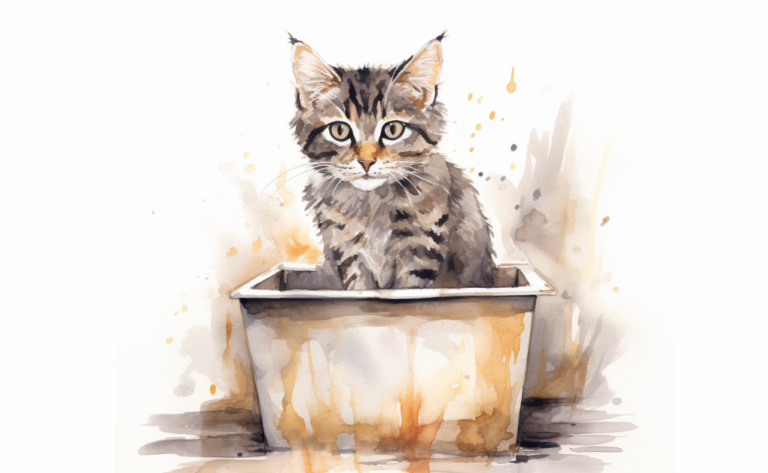What is External Parasite in Cats
What is it?
How is it Treated?
Breed Predispositions
There is no known breed predisposition for external parasites in cats. However, certain breeds may be more susceptible to external parasites due to their environment or lifestyle
Introduction
One sunny afternoon, Sarah noticed her fluffy Maine Coon, Jasper, incessantly scratching and grooming himself. As she took a closer look, she discovered small, crawling creatures on his skin, leaving her startled and concerned. She immediately scheduled a visit to their trusted veterinarian to address the issue.
External parasites in cats, also known as external parasites that affect our feline friends, dwell on the outer surface of a cat’s body, typically living outside its skin or fur. These parasites, including nuisances like fleas, ticks, mites, lice, and the dreaded ear mite, feed on the cat’s blood or tissues. These parasites can take up residence when they find a path onto a cat’s skin or fur, latching on and establishing themselves unwelcome guests.
Each parasite has a unique lifecycle and transmission mode, often relying on close contact with other infected animals or exposure to a bacteria-infected environment. Understanding the presence and factors contributing to these external parasites in cats is critical for creating effective preventive strategies and maintaining the cat’s overall health. However, it’s worth noting that not all parasites in cats are external; cats can also be affected by internal parasites, such as intestinal parasites, which can pose additional health concerns.
Types of External Parasites in Cats
Several types of external parasites can affect cats. Here are the most common ones:
- Fleas are small, wingless insects that infest cats’ fur. They can cause itching, skin irritation, and allergic reactions. Fleas are often visible on the cat’s fur and may leave behind tiny black specks (flea dirt) that resemble pepper.
- Ticks are external parasites that attach themselves to the cat’s skin to feed on blood. They can transmit diseases and cause skin irritation. Ticks can be found in grassy or wooded regions and may be visible as small, dark, or swollen bumps on the cat’s skin.
- Ear Mites are tiny parasites that live in the ear canals of cats. They can cause itching, irritation, and discomfort. Ear mites are often detected by examining the cat’s ears and looking for dark debris or a waxy discharge.
- Mange Mites are microscopic parasites that burrow into the cat’s skin, causing mange. Different mange mites, including Sarcoptes and Demodex, can lead to hair loss, itching, redness, and skin infections.
- Lice are small insects that infest the cat’s fur, particularly in areas with dense hair. They can cause itching, hair loss, and skin irritation. Lice are usually visible on close inspection, and their eggs (nits) may be attached to the hair shafts.
It’s important to note that these external parasites can cause discomfort, skin problems and transmit diseases. Regular monitoring, prevention, and prompt treatment are essential to keep cats healthy and free from infestations. If you suspect your cat has external parasites, consult a veterinarian for proper diagnosis and treatment options.
What Causes Feline External Parasites
Several elements contribute to the prevalence of external parasites in cats. Here’s a rundown of the common causes:
Interaction with Infested Animals
Direct contact with other infested animals is an excellent way for cats to acquire external parasites. This can transpire during encounters with strays, feral cats, or even wildlife species such as raccoons or rodents. Parasites can latch onto cats during physical contact or even when sharing the same living space. Such interactions also cause cats to become infected with various mites, including those responsible for demodectic mange.

Exposure to External Environments
Outdoor environments present numerous opportunities for cats to come into contact with parasites. Ticks and adult fleas often lurk in grassy spots, gardens, and forested areas. Cats indulging their natural curiosity by exploring or hunting outdoors are at a heightened risk of becoming infested with these parasites. Contact with flea dirt and adult fleas’ droppings can also lead to a full-blown flea infestation.
Poor Hygiene and Grooming Practices
Cats without regular grooming or having bad hygiene habits may be more prone to external parasites. Proper grooming routines assist in removing unwanted guests like fleas, ticks, and other parasites from a cat’s fur. Those cats who don’t groom themselves adequately or sport long, tangled coats are at a heightened risk of becoming a host.
Communal Living Spaces
Felines residing in multi-cat homes, shelters, or catteries stand a high chance of exposure to external parasites. In these closely-knit environments, shared living spaces make the transmission of parasites from one cat to another a simple task. If one feline in the group becomes infected, the contagion can quickly spread.
Lack of Preventive Strategies
A frequent cause of external parasite infestations in cats is the failure to carry out regular preventive strategies. Preventive treatments, like topical or oral medications designed to combat fleas and ticks, are vital in managing and preventing infestations. Without these measures, cats become highly susceptible to infestations. Internal parasites live inside the body and can also be a threat; therefore, strategies to combat these should also be part of the prevention plan.
Acknowledging that external parasites can trigger various health issues in cats, from mild skin irritation to more severe conditions such as heartworm disease, is critical. Implementing regular preventive steps, like using flea and tick preventives, maintaining good hygiene and grooming habits, and minimizing exposure to infected animals or environments, can notably diminish the risk of external parasite infestations in cats. For optimal results, consult your veterinarian to pinpoint the most suitable preventive measures tailored to your cat’s needs.
Symptoms of External Parasites Felines
The signs of external parasites in cats can fluctuate based on the type of parasite and the infestation’s intensity. Below are the common symptoms related to external parasites in cats:
- Excessive itching or scratching
- Loss or thinning of fur
- Redness and swelling of the skin
- Skin lesions or wounds
- Visible evidence of parasites
- Alterations in behavior
Intense itching is often a clear signal of an issue. Skin irritation, particularly due to flea bites, can instigate this intense itching. Moreover, mites and ticks can attach to the skin and cause uncomfortable symptoms, including common skin conditions like redness and inflammation.
It’s crucial to understand that these symptoms may also denote other skin ailments or allergies, making it vital to seek professional veterinary advice for a precise diagnosis. The vet can assess the cat’s holistic health, carry out a thorough inspection, and suggest suitable treatment strategies to tackle the specific external parasite infestation. This is especially important, considering parasites like fleas can lead to problems like tapeworm and bacterial infection.
Diagnosis of Cat’s External Parasite
Veterinary professionals employ a variety of techniques to diagnose cats with external parasites. The following are some frequently employed diagnostic methods:

Thorough Physical Inspection
The vet meticulously evaluates the cat’s skin to identify any indications of external parasites. This involves searching for live pests such as fleas or ticks, noticeable eggs or larvae, and any sores, redness, or swelling that might signal a parasitic invasion. The vet will also inspect the cat’s fur for excessive shedding, dandruff, or discomfort.
Skin Scraping Test
This process involves delicately scraping the cat’s skin surface to obtain samples of cells and parasites. The collected substance is then placed onto a microscope slide and scrutinized under a microscope.
The vet will seek out mites, their eggs, or other parasites in the samples. Depending on the suspected parasite, various scraping methods may be implemented, such as superficial scraping for mites or deep scraping for conditions like demodectic mange, where parasites burrow into the skin.
Adhesive Tape Examination
The adhesive tape test is a straightforward, non-invasive technique for gathering samples of external parasites from the cat’s fur or skin. The vet applies transparent adhesive tape to the suspected regions, gently presses it against the fur, and removes it. This tape is then placed on a microscope slide and examined under a microscope. This method assists in identifying pests such as fleas, mites, or lice, as well as their eggs or fecal matter.
Stool Analysis
In instances where internal parasites, like certain worms, are suspected of contributing to the external parasite infestation, a stool analysis may be carried out. The vet obtains a small sample of the cat’s feces and examines it under a microscope. They seek the presence of parasite eggs, larvae, or segments that may indicate the presence of intestinal parasites in the intestines of cats, such as roundworms, hookworms, or tapeworms.
Blood Screening
Blood screenings may be performed to evaluate the cat’s overall health and identify any underlying conditions associated with the external parasite infestation. The blood sample is examined in a laboratory, where various parameters, such as complete blood count, organ function tests, or specific antibody levels, may be evaluated. These screenings help identify abnormalities or systemic diseases that could contribute to the cat’s susceptibility to external parasites or impact its response to treatment, such as the need to treat tapeworms or manage a secondary bacterial infection.
Please note that the particular diagnostic techniques used may vary depending on the suspected parasites, the cat’s symptoms, and the vet’s clinical judgment, often made at an animal hospital. The vet may also use a combination of these methods to achieve an accurate diagnosis and devise an appropriate treatment plan for the infected cat’s specific condition. They aim to alleviate significant discomfort and address the cause of the infestation.
External Parasite Treatment in Cats
The treatment plan for external parasites in cats is determined by the specific parasite found and the degree of the infestation. Below are several common therapeutic strategies based on diagnosis:
Topical Applications
Topical treatments are frequently employed to address fleas, ticks, and mites. These solutions are typically administered directly onto the cat’s skin and function by exterminating or repelling the parasites. They are available in various forms, such as spot-on treatments, sprays, or shampoos with active ingredients like insecticides, acaricides, or insect growth regulators, which are safe for cats.
Oral Treatments
In certain situations, oral treatments may be recommended to manage external parasites. These treatments usually come in tablets or chewable and are effective against specific fleas, ticks, or mites. They work systemically, circulating in the cat’s bloodstream, eliminating the parasites when they bite or adhere to the cat.
Parasite Collars
Flea and tick collars offer another means of treating external parasites. These collars slowly release insecticides or acaricides, providing ongoing protection against fleas, ticks, and sometimes other parasites. They are a convenient option, offering effective protection for several months.
Medicated Shampoos and Dips
Medicated shampoos and dips might be suggested for cats with certain external parasites. These products are used during the cat’s bath and work by eliminating or dislodging the parasites. Regular use or as directed by the veterinarian may be required.
Environmental Interventions
Addressing the cat’s environment is also part of treating external parasites, serving as flea control. This might involve deep cleaning and vacuuming the areas where the cat lives, washing bedding with hot water, and using suitable insecticides or acaricides to destroy any remaining parasites.
Adherence to the veterinarian’s instructions when applying medications or treatments is vital. Some products can harm cats if used improperly, making it crucial to use the correct dosage and only products specifically designed for feline use. Regular follow-up visits to the veterinarian may be necessary to track the cat’s progress and modify the treatment plan as needed, especially if a secondary infection is discovered. Depending on the severity of the infestation, a pet rehab may be recommended to assist in the cat’s recovery.
Prevention for Feline External Parasite
There are several steps pet owners can undertake to assist in the prevention of external parasites in their cats:
- Consistent grooming of your cat aids in maintaining a clean coat and minimizing the risk of external parasites. Brushing your cat’s fur aids in the removal of loose hair and potential pests. It is crucial to pay detailed attention to regions such as the neck, ears, and tail, where parasites may commonly reside.
- Ensuring your cat’s living space is clean and devoid of potential parasite hosts is crucial. Regular house vacuuming, laundering bedding at high temperatures, and keeping outdoor areas tidy can all contribute to diminishing the probability of infestations.
- Utilize parasite prevention products that have been vet-approved to protect your cat against fleas and ticks. Various options exist, including topical treatments, oral medications, and collars. These products are formulated to repel or exterminate fleas and ticks, thereby helping to prevent infestations and avoid severe flea infestations.
- Regular check-ups with your vet should be scheduled. They can carry out routine inspections and propose suitable preventive actions based on your cat’s lifestyle and risk factors. Additionally, they may perform screenings for prevalent external and internal parasites such as intestinal worms.
- Limit your cat’s interaction with stray or infected animals, as they can serve as a source of external parasites. Keep your cat indoors or monitor their outdoor activities to minimize the chance of contact with other animals.
- Good hygiene practices, such as washing hands after handling other animals or items that could be infested, are essential. This helps to prevent the transmission of parasites to your cat’s skin.
- Examine your cat’s fur and skin for any indications of external parasites. Be looking for fleas, ticks, mites, or unusual lumps or irritations. If you observe anything problematic, consult your vet for further examination and advice. Cats can develop an allergy to flea bites and secondary bacterial infections from scratching.
These preventive actions, including seasonal pet care routines, can substantially decrease the likelihood of external parasites affecting dogs and cats, aiding in maintaining their overall health and well-being. Be aware that some treatments are used to treat common parasites, and they can kill the mites responsible for certain infestations. Left untreated, parasites can cause significant health issues and potentially lead to pet emergencies.
Frequently Asked Questions
Disclaimer: The information provided on this veterinary website is intended for general educational purposes only and should not be considered as a substitute for professional veterinary advice, diagnosis, or treatment. Always consult a licensed veterinarian for any concerns or questions regarding the health and well-being of your pet. This website does not claim to cover every possible situation or provide exhaustive knowledge on the subjects presented. The owners and contributors of this website are not responsible for any harm or loss that may result from the use or misuse of the information provided herein.







